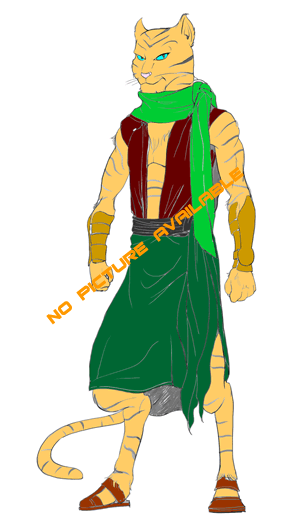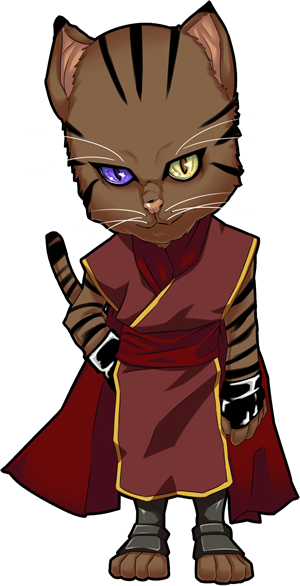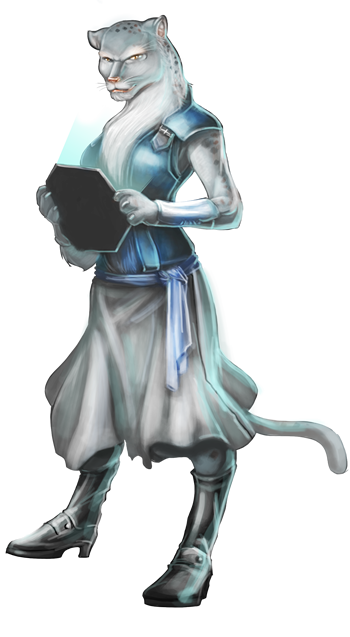Sidebar
Table of Contents
Vonaniom (Clothing)
This page contains information regarding typical clothing worn by the members of the Poku Saeruo Degonjo. Vonaniom (vō-nă-nē-ōm) translates to person cloth.
Most Poku'vonai clothing is uni-sex. Poku'vonai prefer their clothing to be loose-fitting because of their fur.
Basic Items
These are the typical components of Poku'vonai clothing; a brief description is provided for each. More specific details are included in the various subsections.
- Lapur - Lapur (belt) or lapuri (belts) are both ornamental and utilitarian. Adult lapuri are 7.62cm (3inches) wide. They are not used to hold up trousers; belts typically serve as a place to attach personal items, such as holsters, sheaths, and scabbards. A lapur can be made of leather or any similar material. They can be woven from threads, leather strips, and even thin strips of cloth. More luxurious and fashionable belts are made from fine fabrics. Belt buckles vary mainly by the type of material the belt is made from.
- Moqbapa - Moqbapa (footwear) for Poku'vonai are either sandals or boots, although it is not uncommon or unacceptable for anyone to walk around barefoot.
- Bapaumati - Bapaumati (sandals) are the most common footwear worn by Poku'vonai. Because of how the feet of Qaktoro and Tula and their related hybrids are built, sandals have flexible bottoms and are secured with straps that go across the foot and around the ankle.
- Bapawotai - Bapawotai (boots) are normally worn by Poku'vonai performing dangerous work, or if they need to keep their feet dry in a wet environment. Bapawotai are made of flexible, pliable materials, and the upper portion is laced closed after being put on. Bapawotai are rarely worn by young Poku'vonai because they grow so quickly, fitting and resizing boots every year would be a foolish endeavor.
- Umatli - An Umatli kilt is the main garment that Poku'vonai wear. Properly fitted, it secures at the waist and hangs down to the center of the knee. The Kilt is secured with straps, buttons or clasps.
- Umatsa - The Umatsa (robe) is the Poku'vonai equivalent of a kimono. The flowing fabric and open sleeves make this very comfortable for them to wear.
- Lapurnium - A Lapurnium (sash) is most often worn for decorative purposes. Sometimes a Poku'vonai will use a sash to carry small objects by tucking them in between their fur and the sash, or they will have pockets made in the sash itself.
- Hodiwota - Hodiwota (trousers) for a Poku'vonai are over-sized to keep them from irritating the fur on their legs. These trousers are secured at the waist with either ties or buttons. They are worn with the bottoms hanging free, or with the bottoms tucked into boots. Depending on the design, some trousers have pockets and others do not.
- Jendomu - A Jendomu (tunic) is a sleeveless top garment. It consists of a full back covering and two sections that drape up over the shoulders and down across the chest. Some tunics are held in place with a belt or a sash. Other Tunics have 2-3 fasteners that hold the front closed. The sides of the tunic are open.
- Working: Lower ranking members wear their Punla (Family), Ruoka (House), and rank markings on their Umatli. Rank is worn on the upper left, and the other symbols on the right. Typically the symbols are embroidered onto the Umatli
- Niomse - A Niomse (literally lower cloth) is the Poku'vonai version of underwear. They feature ties or buttons on the sides to secure them around the waist. Usually only worn outside the home, or at outdoor activities.
- Duinjen - A Duinjen (Literally chest cloth) is the Poku'vonai version of a shirt. They are loose fitting and secure on the side. They come in long sleeve, short sleeve or no sleeve versions. The are a casual item typically worn when working.
 |
|
|---|---|
| Above: This Tula is wearing a bright green | |
| Jendogo tied around their neck, a maroon Jendomu, a dark | |
| green Umatli, and maroon Bapaumati. |
Casual
This covers the kinds of clothing that a Poku'vonai would wear when relaxing either at home, or at recreational activities.
- Lapur - (belts) Usually not worn in the home, but can be worn at casual events.
- Moqbapa - (footwear) In the home Poku'vonai normally go barefoot, normally they will wear Bapaumati sandals when attending recreational activities, or at least to them.
- Umatli - (kilt) This is the most commonly worn item at home, and at recreational activities.
- Umatsa - (robe) Commonly worn in the home and on the grounds, color and style up to the individual.
- Lapurnium - (sash) Usually not worn in the home, but can be worn at casual events.
- Hodiwota - (trousers) Usually not worn at home for day to day activities, but is worn when performing messy tasks around the home.
- Jendomu - (tunic) Not usually worn in the home unless a festivity is taking place.
- Niomse - (underwear) Not usually worn in the home, but often worn under an umatli when out of the house.
Working
This covers the kinds of clothing that a Poku'vonai would wear when performing their occupation.
- Lapur - (belts) Most occupations require the wearing of a lapur. Typically it is to hold tools or weapons.
- Moqbapa - (footwear) Depends on the job, or task. Normally worn when foot protection is required.
- Umatli - (kilt) Worn by all members when working. Lower ranking members wear their Punla (Family), Ruoka (House), and rank markings on their umatli. Rank is worn on the upper left, and the other symbols on the right. Typically the symbols are embroidered onto the umatli
- Umatsa - (robe) Normally only worn by Kyn Lumu'ai Jael (Lore Keepers Sect) and Kavoráy Rây'ai Jael (Oath Binders Sect), color is typically their Ruoka (House).
- Lapurnium - (sash) Most often worn by Kyn Lumu'ai Jael (Lore Keepers Sect) and Kavoráy Rây'ai Jael (Oath Binders Sect), color is typically their Punla (Family).
- Hodiwota - (trousers) are normally only worn for a specific task. No symbols are worn on them.
- Hapuwota - Hapuwota (Gloves) are used in some professions to protect the hand.
- Jendomu - (tunic) Normally worn to distinguish ranking members, from lower echelon. Rank is worn on the left side, and the house and family on the right.
- Niomse - (underwear) Worn by all members when working.
 |
|
|---|---|
| Above: This Qaktoro is wearing a maroon Jendomu with gold trim | |
| over a white Duinjen and white Umatli. He has a blood-red cloth Lapurnium | |
| that hangs from his back like a cape, and which is tucked into his Jendomu. | |
| Around his waist is a Lapurnium of the same blood-red cloth as his Lapur. | |
| He wears black Bapaumati that wrap up above the ankle. |
Formal
This covers the kinds of clothing that a Poku'vonai would wear for important ceremonies, and Devotopai (Rituals).
- Lapur - (belt) Normally ornate and in some events are essential as well as symbolic.
- Moqbapa (footwear) Bapaumati (sandals) are the norm for most formal occasions.
- Umatli - (kilt) Worn when present at an event as a spectator. Typically worn in Ruoka (House) colors without adornments
- Umatsa - (robe) Normally worn when participating in the ceremony directly. Color would be either Jaeli (Sects), Ruoka (House), or Family Sect symbol, family heraldry, worn or part of.
- Lapurnium - (sash) Optional for most events, but an essential component in some rituals.
- Hodiwota - (trousers) not worn during formal events.
- Jendomu - (tunic) Normally in Jaeli (Sects) or Ruoka (House) colors, with the Jaeli (Sects) and Punla (Family) symbols on the left segment and the family Afirmugaly (Heraldry) on the right.
- Niomse - (underwear) Worn at all events.
Traditional Festive Clothing
- Safarisa - (flowing silks) This garment is traditionally worn by a Tuima'a (Dancer) when they are performing. It consists of pants and a tunic that are form-fitting, but have colored silk cloths that attach at the shoulders, wrists, hips and tail. This allows the Dancer to get maximum movement from the flowing fabric. In more recent times, Safarisa made of satin have become popular for wearing to social dancing events, such as those found in Night Clubs.
Inclement Weather
This covers the kinds of clothing that a Poku'vonai would wear when having to go out during inclement weather.
Rain
- Jendogo - (cloak) A jendogo is worn during heavy rains. They can be manufactured from natural or artificial waterproof substances. It is worn over regular clothing, and has a built in hood. Most common ones have a fastener or a series of buttons to hold them closed.
- Moqbapa - (footwear) Bapaumati (sandals) or bapawotai (boots) are typically worn to improve traction.
Cold
Poku'vonai are more comfortable in warmer climes. Cold weather approaching the freezing point affects them more than it would a human. These are only worn when off station.
- Jendogo (cloak) These tend to be made of either fabric or fur, and have lining to increase the thermal protection.
- Wotamu - (coat) A Poku'vonai coat is long so as to cover most of the body, they resemble a duster. They usually have a built-in hood.
- Moqbapa - (footwear) bapawotai are worn when in snow or ice conditions.
- Hapuwota - Hapuwota (Gloves) are used to keep the Poku'vonai hand warm.
- Hodiwota - (trousers) Are worn in very cold conditions to protect the legs.
- Jendomu - (tunic) are sometimes worn under a wotamu, occasionally they are modified with sleeves.
 |
|
|---|---|
| Above: This female Qaktoro is wearing | |
| a dark blue Jendomu, an ice-blue Lapurnium, | |
| a white Umatli and black Bapawotai. |
OOC Notes
- Article by Nashoba. Art on this page by various artists.
Page Tools
Terms of Service - Privacy Policy
